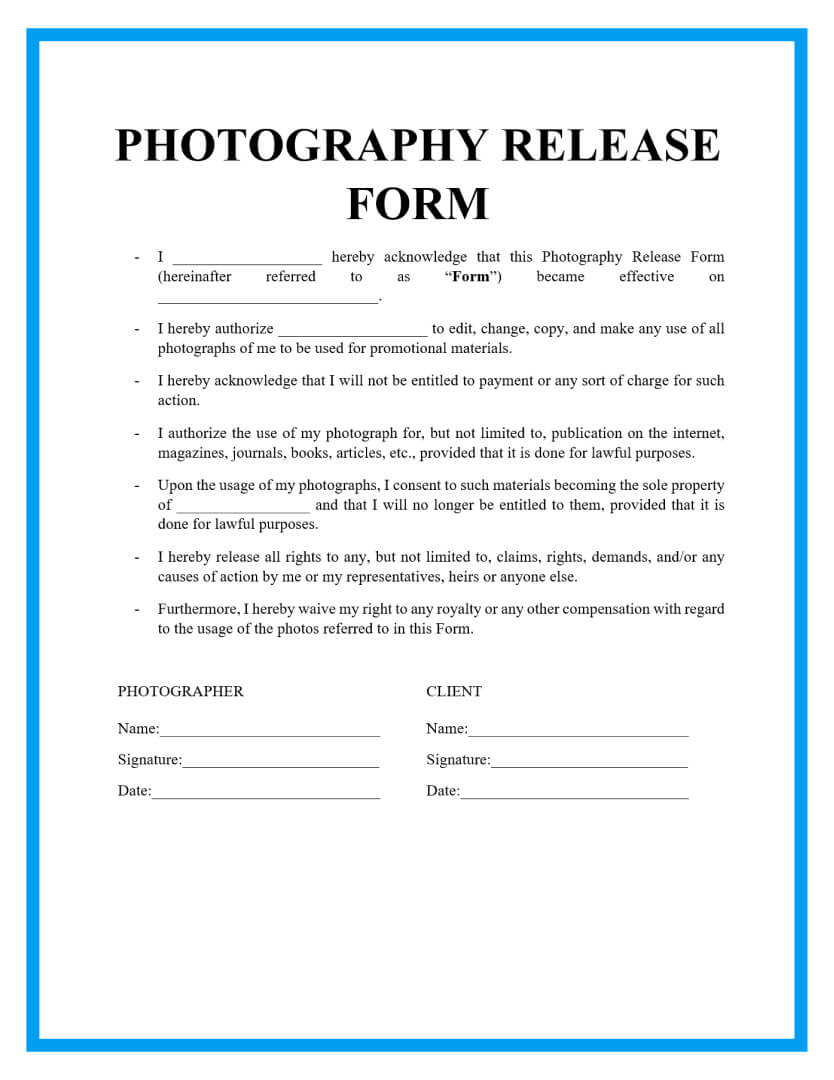
Whether you’re a beginner photographer learning composition on your smartphone, a hobbyist with medium grade equipment, or a full-blown professional, it’s essential to understand the importance of a photography release form and when to use it.

Whether you’re a beginner photographer learning composition on your smartphone, a hobbyist with medium grade equipment, or a full-blown professional, it’s essential to understand the importance of a photography release form and when to use it.
To make life easy for you, we’ve gone ahead and created a standard photo release form template (PDF and Word) for you to review and use when needed.
Click below to get your free photography release form template.Imagine you’re casually browsing the internet one day to discover a random image with you in the frame. You instantly remember where you were at the time the photo was taken, but you don’t recall anyone ever photographing you.
You’re shocked and possibly scared at this point. Is someone stalking you? How did this happen? Why is this photo of me online!?
A photo release consent form is a legally binding contract between a photographer and a subject. A subject could be a client for a professional shoot, a property, branding, or a random person at the beach.
When it comes down to it, a photographer needs legal permission to publish images of people and property.
DISCLAIMER: We are not lawyers or a law firm and we do not provide legal, business or tax advice. We recommend you consult a lawyer or other appropriate professional before using any templates or agreements from this website.
As a photographer, it’s better to be safe than sorry when it comes to privacy and copyright. Save yourself the time, hassle, and headaches and use our free photography release form, so you can focus on creating beautiful photographs.
Click below to download our free photo consent formYou need a photography model release form if a person is in an image. Conversely, you don’t require a model release form if the person in the picture is unrecognizable.
Also, you need a photo release form for identifiable private premises, including residential or business property. Property in this context is also extended to trademarks, artwork, landmarks, logos, and pets.
Put it this way; if you capture a photo with a recognizable person or identifiable property of a person, you’ll need a photo release form.
You don’t need a photo consent form if the subject or location is unidentifiable. For example, you can photograph a landscape of a random mountain that looks similar to the 1000s of different mountains. Or you capture a leg of a person in a photograph, and it’s almost impossible to tell who it is.
As long as you can prove that your subject is unidentifiable beyond a reasonable doubt, then a photo release form isn’t required.
So let’s say you’ve planned a shoot for personal or commercial purposes and you want to capture an identifiable subject that is owned by a person, how do you approach them with your form?
It can be quite confronting to explain your photo release policy, especially to strangers!The first thing is first, make sure you have your photography release form on hand. It will be tempting to proceed without the documents, or trust that the models will sign them later, but it’s important to hold off the shoot until you have the signed documents.
When presenting the model release form template, don’t make a big deal of it. Tell your client that you need them to sign your photo release form before proceeding with the shoot. Ask them to read over your form and sign when they’re ready.
More often than not, clients will read through your contract and sign it without any questions asked. After all, they’d likely know in advance that you’re a photographer, and they expected that you’d have ownership over the images.
If they do have questions about your release form, calmly, and firmly address their queries. Sometimes it’s worth explaining how you’ll be using the photos to put the clients’ mind at ease.
You could take it a step further and give them examples of how you’ve used client images in the past. This creates a level of normalcy with the nature of your work.
Frequently Asked QuestionsIf you take a snap of an identifiable subject for enjoyment or artistic expression for yourself, then you don’t need a release form.
However, if you plan on publishing or selling an image of an identifiable subject, then you’ll need a photography release form.
While photo and model release forms are often used interchangeably in the photography world, technically, there are some differences between the two contracts.
A model release form effectively gives ownership of an image to the photographer. That is, a subject provides permission to the photographer to use the photos for whatever they want.
A photo release form gives ownership to the client. So if a photographer takes professional photos of you, by default, the photographer owns those images, and you need permission from them to use it.
To summarise, a model release form benefits the subject, and a photo release form benefits the photographer. But, commonly, these terms are used to describe both situations.